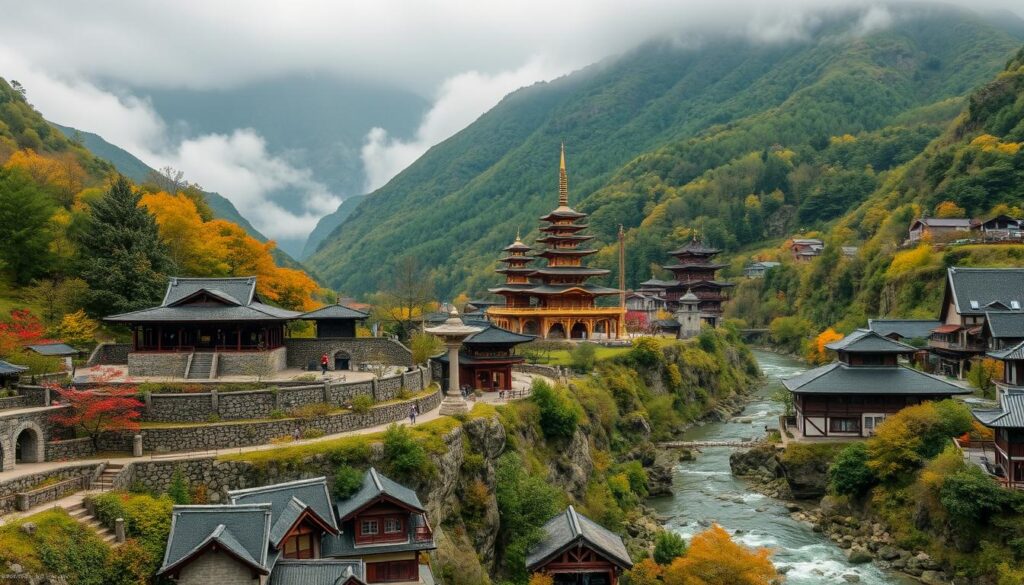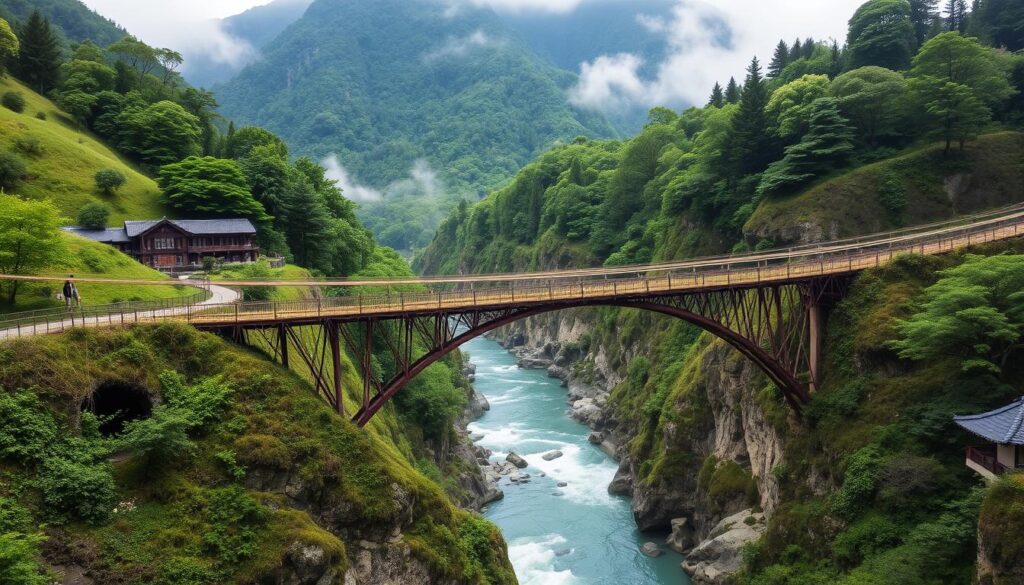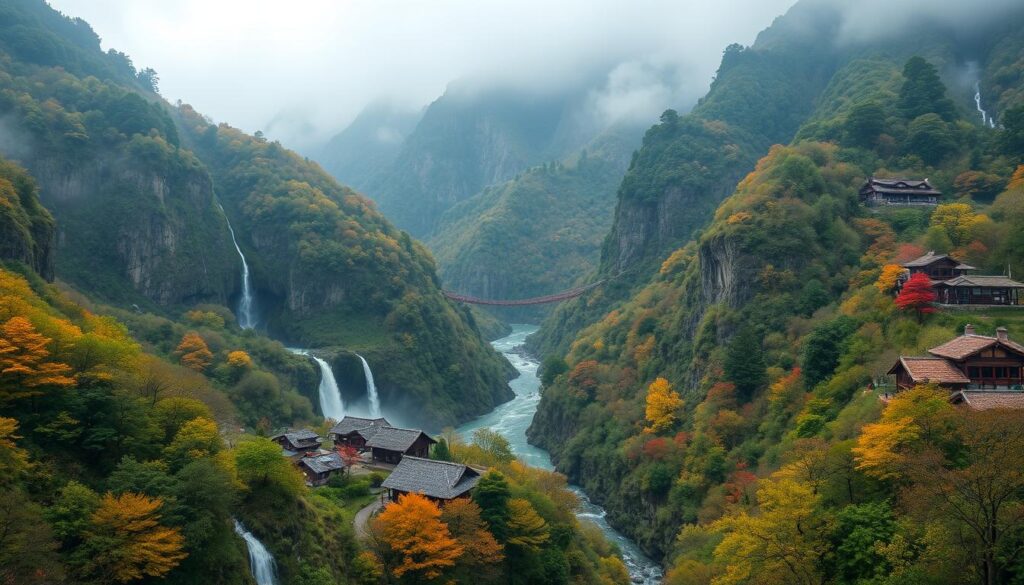The Iya Valley is a hidden gem in Japan’s rugged mountains. It’s on Shikoku Island and offers a rare look at Japan’s natural beauty and culture. But what secrets does this enchanting valley hold? Let’s explore the wonders of Iya Valley together.
This place has long fascinated travelers looking for a real Japan experience. It’s a journey into the heart of Japan’s untouched beauty.
Key Takeaways
- Iya Valley is a hidden gem on Shikoku Island, offering breathtaking landscapes and unspoiled natural beauty.
- The remote valley is known for its deep gorges, traditional villages, and rich cultural heritage.
- Visitors can explore a unique ecosystem, hike scenic trails, and immerse themselves in the local way of life.
- Iya Valley is an off-the-beaten-path destination that provides a rare glimpse into Japan’s untouched rural regions.
- The valley’s famous Kazurabashi vine bridges are engineering marvels that showcase the region’s ingenuity and tradition.
Exploring the Remote Beauty of Iya Valley Japan
The Iya Valley is a hidden gem in Tokushima Prefecture. It offers stunning and remote landscapes that draw in visitors. This rugged area is known for its steep ravines, lush forests, and breathtaking views.
Geographic Location and Climate
Iya Valley is in the heart of Shikoku Island, one of Japan’s main islands. It has a varied climate, with warm and humid summers and cold winters. Higher elevations see occasional snowfall.
Natural Landscapes and Scenic Views
The valley’s rugged terrain shows its geological history. The Oboke Gorge and its cliffs are a highlight. Visitors can hike through dense forests, enjoying stunning views.
The Valley’s Unique Ecosystem
Iya Valley’s remote location has preserved its natural ecosystem. It’s home to diverse flora and fauna. Nature lovers and wildlife photographers find it a treasure trove of biodiversity.
Ancient History and Cultural Heritage of the Valley
Iya Valley is deep in the mountains of Tokushima Prefecture. It has a rich history that has shaped its culture. In the 12th century, it was a hideout for the Taira clan during the Genpei War. This event left a lasting impact on samurai history.
The valley’s past is marked by a unique architectural style. It combines traditional Japanese architecture with nature. Visitors can explore historic sites and villages. Here, old customs and spiritual practices still thrive.
- Explore the remnants of Iya Valley’s Taira clan legacy, including ancient fortifications and hidden settlements that offer a glimpse into the region’s samurai history.
- Discover the intricate designs and craftsmanship of traditional Japanese architecture, from thatched-roof farmhouses to centuries-old temples and shrines.
- Participate in spiritual retreats and traditional ceremonies, where you can delve into the valley’s rich cultural heritage and connect with the land’s deep-rooted historic sites.
Iya Valley’s history and culture make it special. It invites visitors to learn about Japan’s past through cultural immersion.

“The valley’s rugged beauty and its role as a refuge for the Taira clan have made it a place of profound historical and cultural significance in Japan.”
The Famous Kazurabashi Vine Bridges: Engineering Marvels
In Japan’s Tokushima prefecture, the Kazurabashi vine bridges are a sight to behold. They are ancient suspension bridges made from local vines. These bridges show the cleverness and hard work of the people who built and kept them for years.
Construction and Maintenance
The Oku-Iya Niju Kazurabashi, or “Double Vine Bridges of Iya,” are famous for their beauty. They use strong vine bridges of Iya to cross deep ravines and fast rivers. This is thanks to the skill of the local people.
Keeping these engineering marvels in good shape is a big job. The vines need to be fixed and replaced often. Local artists and volunteers work hard to keep the tradition alive and safe for visitors.
Best Viewing Points and Photography Tips
Walking on the Kazurabashi vine bridges is thrilling. It gives you a special view of the Iya Valley’s stunning scenery. The Oku-Iya Niju Kazurabashi is the best place to see, with its twin bridges over a deep gorge.
Remember, the bridges are narrow. Take your time and be careful. Use a camera with a wide lens to capture the beauty of these engineering marvels.
Safety Guidelines and Visiting Hours
The Kazurabashi vine bridges are open to everyone. But, it’s important to follow safety rules. They are open from spring to autumn, but not in bad weather or when they’re being fixed.
- Wear sturdy, non-slip footwear when crossing the bridges.
- Keep a firm grip on the handrails and move slowly and cautiously.
- Avoid crossing the bridges during high winds or heavy rain.
- Respect any closures or restricted areas for maintenance or repairs.
By following these rules and respecting the bridges, you can enjoy crossing them. It’s a unique and amazing experience.

Traditional Mountain Villages and Architecture
In the heart of Iya Valley, Japan, lies a treasure trove of traditional mountain villages. These villages show off the area’s rich culture. They feature thatched-roof houses, symbolizing the community’s dedication to living sustainably.
Visiting these remote villages feels like a journey back in time. Here, life moves in sync with nature. You can see the real traditional villages and the skill passed down through generations.
The houses in these villages are architectural wonders. Their thatched roofs are made from local materials, offering protection and blending with the scenery. This design reflects the valley’s commitment to sustainable living, inspiring visitors to find harmony with nature.
Walking through the narrow streets of these traditional villages feels magical. The preserved buildings, with their woodcarvings and paper lanterns, enchant everyone. They invite visitors to experience the timeless beauty of Iya Valley.
Outdoor Adventures and Natural Hot Springs
Iya Valley is a hidden gem in the Shikoku mountains. It’s perfect for outdoor lovers. Here, you can explore stunning landscapes, from green forests to snowy peaks.
Hiking Trails and Mountain Activities
Iya Valley has trails for every hiker. Experienced adventurers can tackle tough paths for amazing views. For a calm walk, try the valley’s peaceful forests. You can also rock climb or go canyoning for an extra thrill.
Onsen Experience and Wellness
Visiting Iya Valley isn’t complete without trying the natural hot springs, or onsen. These waters are full of minerals and are great for relaxing. Surrounded by nature, you can unwind and find peace.
Seasonal Outdoor Recommendations
- Spring: See the beautiful cherry blossoms and enjoy the green trails.
- Summer: Have fun in the Iya River with rafting and canyoning.
- Autumn: Take in the stunning fall colors on scenic hikes.
- Winter: Enjoy skiing and snowshoeing in the snowy landscapes.
Iya Valley offers both exciting adventures and peaceful moments. It’s a paradise for those who love nature and wellness.
Local Cuisine and Cultural Experiences
In the stunning Iya Valley, Japan, visitors embark on a special culinary and cultural adventure. The local food highlights the area’s rich ingredients, mixing old cooking ways with new ideas.
The Iya Valley is famous for its Iya soba, handmade buckwheat noodles. These noodles are served cold with a tasty sauce, letting the buckwheat’s flavor stand out. The area is also known for dishes made from wild game like venison and boar, found in the valley’s green forests.
The Iya Valley is gaining fame for its winemaking. Local vineyards make unique Japanese wines that show off the region’s unique taste. Visitors can visit the vineyards, learn how wine is made, and taste the valley’s special wines.
The Iya Valley also offers a rich cultural experience. Guests can try traditional crafts workshops, seeing how local textiles, pottery, and woodcarvings are made. The valley’s deep Zen Buddhism roots are shown in peaceful tea ceremonies, where guests learn about mindful tea making.
“The Iya Valley is a hidden gem, where the essence of traditional Japanese culture and cuisine is preserved, offering visitors a truly authentic and unforgettable experience.”
Whether you love food, culture, or just want to connect with nature, the Iya Valley is a journey worth taking. It’s a deep dive into rural Japanese tourism, filled with unforgettable moments.
Essential Travel Guide and Transportation Tips
Planning a trip to the Iya Valley in Japan needs careful thought about how to get there. This area is far away and can be hard to reach. Knowing the best time to go depends on what you want to do and see.
This travel guide has key tips for a smooth and green trip. It covers where to stay and how to explore the valley’s beauty and culture responsibly.
Getting to the Iya Valley is possible by public or private transport. You can take a train, bus, or rent a car. Renting a car gives you the most freedom. For a greener choice, try hiking or guided tours to see the valley’s beauty without harming the environment.
It’s important to know how to get around. Look up schedules, plan your path, and learn about local rules. This way, your trip will be easy and fun.
Choosing the right time to visit the Iya Valley is crucial. The area changes with the seasons, each with its own charm. Spring and fall are the best times for nice weather and beautiful views.
Summer is great for outdoor fun. Winter is calm and peaceful, perfect for a quiet getaway.

